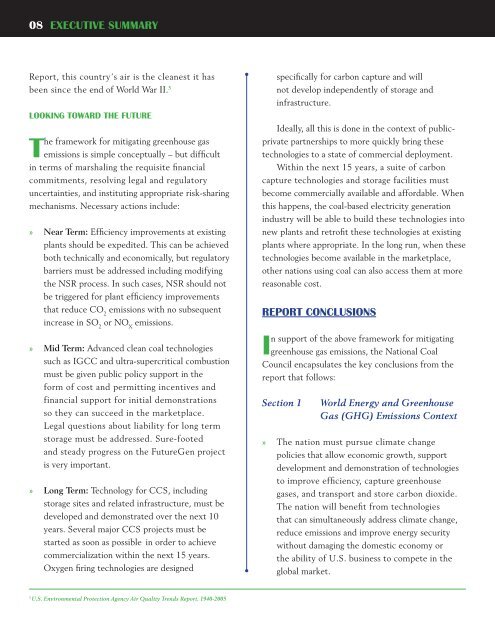Technologies to Reduce or Capture and Store Carbon Dioxide Emissions
TECHNOLOgIEs to Reduce or Capture and store Carbon Dioxide ...
TECHNOLOgIEs to Reduce or Capture and store Carbon Dioxide ...
Create successful ePaper yourself
Turn your PDF publications into a flip-book with our unique Google optimized e-Paper software.
08 executive summary<br />
Rep<strong>or</strong>t, this country’s air is the cleanest it has<br />
been since the end of W<strong>or</strong>ld War II. 5<br />
Looking Toward the Future<br />
The framew<strong>or</strong>k f<strong>or</strong> mitigating greenhouse gas<br />
emissions is simple conceptually – but difficult<br />
in terms of marshaling the requisite financial<br />
commitments, resolving legal <strong>and</strong> regula<strong>to</strong>ry<br />
uncertainties, <strong>and</strong> instituting appropriate risk-sharing<br />
mechanisms. Necessary actions include:<br />
» Near Term: Efficiency improvements at existing<br />
plants should be expedited. This can be achieved<br />
both technically <strong>and</strong> economically, but regula<strong>to</strong>ry<br />
barriers must be addressed including modifying<br />
the NSR process. In such cases, NSR should not<br />
be triggered f<strong>or</strong> plant efficiency improvements<br />
that reduce CO 2<br />
emissions with no subsequent<br />
increase in SO 2<br />
<strong>or</strong> NO X<br />
emissions.<br />
» Mid Term: Advanced clean coal technologies<br />
such as IGCC <strong>and</strong> ultra-supercritical combustion<br />
must be given public policy supp<strong>or</strong>t in the<br />
f<strong>or</strong>m of cost <strong>and</strong> permitting incentives <strong>and</strong><br />
financial supp<strong>or</strong>t f<strong>or</strong> initial demonstrations<br />
so they can succeed in the marketplace.<br />
Legal questions about liability f<strong>or</strong> long term<br />
s<strong>to</strong>rage must be addressed. Sure-footed<br />
<strong>and</strong> steady progress on the FutureGen project<br />
is very imp<strong>or</strong>tant.<br />
» Long Term: Technology f<strong>or</strong> CCS, including<br />
s<strong>to</strong>rage sites <strong>and</strong> related infrastructure, must be<br />
developed <strong>and</strong> demonstrated over the next 10<br />
years. Several maj<strong>or</strong> CCS projects must be<br />
started as soon as possible in <strong>or</strong>der <strong>to</strong> achieve<br />
commercialization within the next 15 years.<br />
Oxygen firing technologies are designed<br />
specifically f<strong>or</strong> carbon capture <strong>and</strong> will<br />
not develop independently of s<strong>to</strong>rage <strong>and</strong><br />
infrastructure.<br />
ideally, all this is done in the context of publicprivate<br />
partnerships <strong>to</strong> m<strong>or</strong>e quickly bring these<br />
technologies <strong>to</strong> a state of commercial deployment.<br />
Within the next 15 years, a suite of carbon<br />
capture technologies <strong>and</strong> s<strong>to</strong>rage facilities must<br />
become commercially available <strong>and</strong> aff<strong>or</strong>dable. When<br />
this happens, the coal-based electricity generation<br />
industry will be able <strong>to</strong> build these technologies in<strong>to</strong><br />
new plants <strong>and</strong> retrofit these technologies at existing<br />
plants where appropriate. In the long run, when these<br />
technologies become available in the marketplace,<br />
other nations using coal can also access them at m<strong>or</strong>e<br />
reasonable cost.<br />
REPORT CONCLUSIONS<br />
In supp<strong>or</strong>t of the above framew<strong>or</strong>k f<strong>or</strong> mitigating<br />
greenhouse gas emissions, the National Coal<br />
Council encapsulates the key conclusions from the<br />
rep<strong>or</strong>t that follows:<br />
Section 1<br />
W<strong>or</strong>ld Energy <strong>and</strong> Greenhouse<br />
Gas (GHG) <strong>Emissions</strong> Context<br />
» The nation must pursue climate change<br />
policies that allow economic growth, supp<strong>or</strong>t<br />
development <strong>and</strong> demonstration of technologies<br />
<strong>to</strong> improve efficiency, capture greenhouse<br />
gases, <strong>and</strong> transp<strong>or</strong>t <strong>and</strong> s<strong>to</strong>re carbon dioxide.<br />
The nation will benefit from technologies<br />
that can simultaneously address climate change,<br />
reduce emissions <strong>and</strong> improve energy security<br />
without damaging the domestic economy <strong>or</strong><br />
the ability of U.S. business <strong>to</strong> compete in the<br />
global market.<br />
5<br />
U.S. Environmental Protection Agency Air Quality Trends Rep<strong>or</strong>t, 1940-2005


